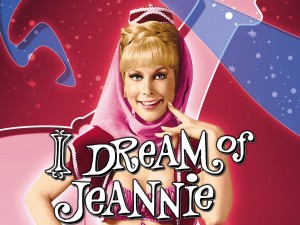You heard it here first, set top boxes (or sticks) are a transitional technology. The Genie ( and I hope it’s Jeannie) is about to leap our of her bottle. 
Right now you can buy about a dozen so-called “over the top” TV technologies that come with all kinds of boxes with which you can violate your television’s auxiliary inputs.
They’re all basically the same, but vary in terms of the deals they cut with content providers. They range from the new Apple TV offering (using the old box – now cheaper dang it!) to Play Station to Sling.
But each of these damned things only gestures at where we’re inexorably heading – toward a platform agnostic, open IP experience on your TV.
What the hell does that mean? It means that despite all efforts to keep the proverbial Genie locked in her bottle – you will eventually bookmark your favorite live-streaming TV channels in a beautiful user-friendly interface, and click between them effortlessly no matter what device you’re using to watch, or which content provider you are patronizing.
Every TV “channel” will be a website streaming its content live on its home page, with a library of back episodes to watch. You’ll aggregate your subscriptions and pay a monthly bill based on the programming you choose to consume. No more being forced to take the Wet Turtle Olympics channel as part of your programming bundle.
The technology to do this exists NOW. It’s just the sword-fighting over the revenue models that keep the Genie locked in her bottle. But it’s not going to last.
What does this mean for the cable companies? That delivering bits and bites is the same damned thing no matter the type of content. It is a commoditized business, BUT it is a monopoly. Here’s the rub: you still need the broadband connection, and the big MSOs/ISPs (ah, they’re both!) will continue to reap the benefits of having the only wire strung into your home – the installation costs of which they have long since recovered. Your local broadband provider will probably also aggregate your bill on behalf of your subscriptions. It too is a commoditized service, but it’s part of the back end they can continue to provide and charge programmers for.
That means the money will be flowing to video production content creators – as well it should be. It also means a rush to compete with broadband providers through the use of a new generation of wi-fi or over-the-air delivery (possibly high-altitude drone-based – i.e. Facebook), and the end to content providers who exist only on the margins of cable TV packages.
This isn’t complicated: you want to watch the channels you want to watch, when you want to watch them, on the device of your choice. Right now the MSOs, the ISPs and the content providers are too busy fighting each other to deliver the service we all want.
Don’t fret. Jeannie will wiggle her nose in a couple of years.









